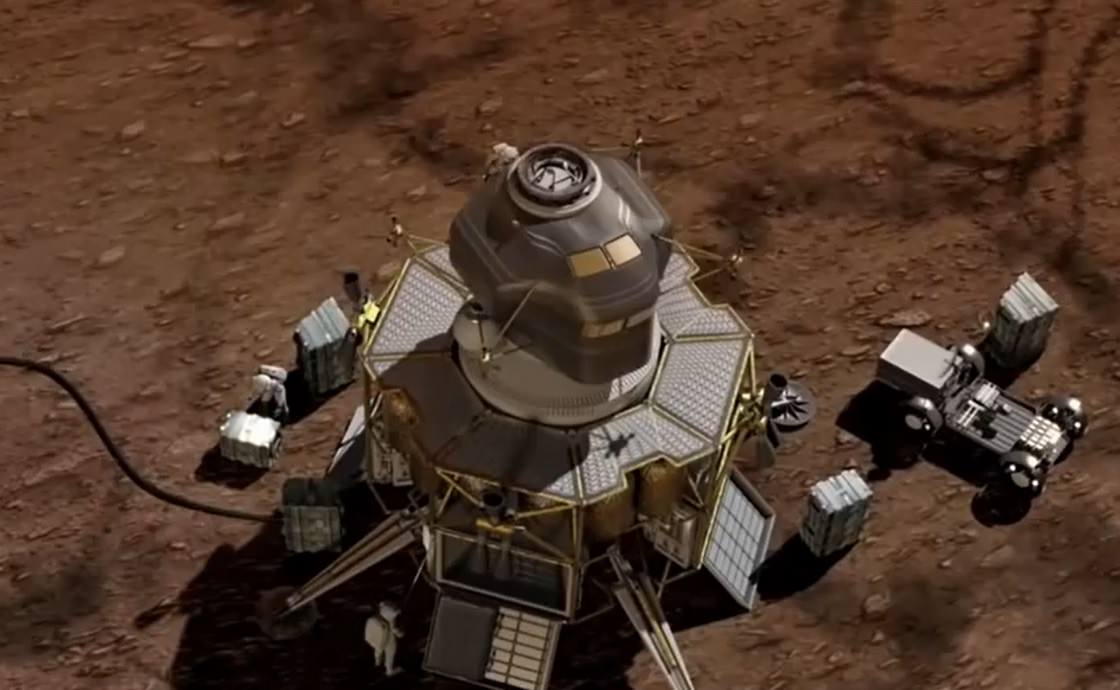Can the just-flown Orion spacecraft truly get us to Mars? NASA has been portraying the mission as part of the roadmap to the Red Planet, but there are observers who say a human landing mission is an unrealistic goal given the budget just isn’t there right now in Congress.
That doesn’t stop Boeing from dreaming, though. In this new video, the prime contractor for the future Space Launch System rocket suggests that going to Mars will take six spacecraft elements. Two are in the works right now — Orion and SLS — while a Mars lander and other bits are just ideas right now, but shown in the video.
According to Boeing, the missing elements include a deep-space tug, a habitat, a lander and a rocket designed to get up out of the Mars gravity well. They also suggest it will take several SLS launches to assemble all the pieces to bring humans to the Red Planet.
“I think we’ll be able to colonize Mars someday,” said Mike Raftery, director of Boeing Space Exploration Systems, in the video. “It’ll take time. It may take hundreds of years. But that’s not unusual for humans. It’s really about establishing a human foothold on the planet. It’s a natural evolution of humanity to take this challenge on.”
That said, the video does hold to the old joke that a Mars landing is always 20 years in the future; the opening sequence suggests that the landing would take place in the 2030s and that those first astronauts are between the ages of 10 to 20 right now. What will it take to make the Mars mission possible? Let us know in the comments.
Edit, 3:39 p.m. EST: Thank you to a reader on Twitter, who pointed out this presentation by Boeing that explains the concepts in more detail.


Too funny. BFR and MCT will beat them there.
The idea of a solar-electric transfer vehicle is laudable. Almost every Mars mission design I’ve seen has almost no reusable element. Such a vehicle could return to Earth orbit and be reloaded for the next flight, minimizing the number of launches, all thanks to its high fuel efficiency.
We need lower-cost rockets to launch large payloads to orbit and low-cost crew-launch options. I really hope SpaceX succeeds in their goals, because there aren’t any other players likely to succeed in the near term. NASA, with SLS and Orion, clearly only care about getting the super heavy launch and crew capability but not at a price that will be affordable to actually use.
If launch costs can be driven down, it will be a smaller step to do the in-space assembly and other design work to enable a sustained human presence on Mars or elsewhere in the solar system. But a human mission to Mars will never happen with SLS’s launch costs.
There is no need for either SLS or Orion’s shield, both of which would save plenty of money for other purposes, which are more essential to human expansion into space. Both are just an example of political engineering :
https://www.youtube.com/watch?v=MQRPbZNRKAo
So, if we drop SLS and Orion’s shield, we are doomed ? Not really. SpaceX or any other will get us into orbit where our ship waits at the gas station :
http://en.wikipedia.org/wiki/Propellant_depot
And here’s the ship to take us anywhere in the solar system, for now :
Nautilus-X
http://en.wikipedia.org/wiki/Nautilus-X
I dont think cost is a real factor.
A cheaper mission is possible but not cheap enough to just slip it into a budget.
To get past congress it’s got to benefit their districts and egos.
Promising a fancy new ship in a simple staged format is a play to get the green light for continuation.
Maxwell, I think that’s only arguably true if the goal is only a single flags & bootprints mission with no lasting human presence in deep space. I’ve been reading articles about SLS being so expensive that it is unlikely to ever be launched more than once a year. The Boeing video claims 5-6 launches for their reference mission. So I guess it’s possible that Congress might be willing to fund a single mission to stroke their egos and send some pork to their districts.
But long term habitation? A permanently staffed research base? Those things will never be done with SLS. Which means another, lower cost, platform will have to be developed. If SpaceX can’t pull off their goal of a (mostly) reusable BFR/MCT, we are going to be in the same place with Mars in 70 years as we are with the Moon today. “Yeah, we went there once but it’s not worth the expense to go back.”
Well, I’m not satisfied with that. I believe that humanity’s goal should human colonies on the Moon and Mars. NASA’s HSF goal should be permanently staffed research bases on those bodies.
To achieve that, launch costs must first come way down. NASA/Congress has already wasted decades by refusing to aggressively evolve the shuttle program towards greater re-usability. Now they have replaced shuttle with a fully expendable rocket, effectively turning the clock back to 1970.
The simple fact is that SLS is a short-sighted move which disgusts me both as an American and a human being.